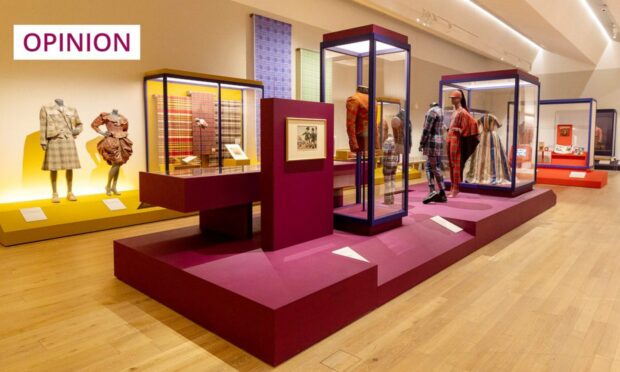Billed by V&A Dundee as “the must-see show of the year”, and opening to rave reviews, new exhibition Tartan aims to “celebrate the global story of a unique pattern” by bringing together “dazzling objects from around the world”.
That language isn’t overdone. What’s presently to be seen in the now five years old but still spectacular V&A building on Dundee’s waterfront is remarkable in its range, diversity and impact.
That’s because there can be no one take on tartan. It has clothed monarchs. It has clothed slaves. Jacobite rebels wore tartan. But so did the Scottish regiments that helped expand the British Empire into Africa, Asia and North America.
This and much else is evident from an hour or three spent with what Tartan’s organisers have put on display. Among more than 300 items from over 100 different lenders are a 1960s Hillman Imp with a tartan interior; Sir Jackie Stewart’s racing helmet, banded in Royal Stewart tartan; streetwear from Japan; Bay City Rollers tartan flares; a scrap of 16th century tartan, excavated from a peatbog in Glen Affric; high fashion garments from Vivienne Westwood; See You Jimmy hats; an 18th century dress; porridge bowls, snuff boxes, postcards, portraits, railway posters.
So, why, among so much that’s colourful, not to say garish, am I lingering in front of a piece of fabric that’s entirely black and white?

Who wove this fabric will forever be a mystery. But it dates, so textile experts reckon, from around 1830. Rectangular in shape, more than six feet long and nearly four feet wide, it’s a surviving and well-preserved example of a shepherd’s plaid.
Made from two shades of raw, undyed, untreated wool – and, thus, retaining the rain-resistant qualities of a sheep’s fleece – plaids were the nearest thing Victorian shepherds had to waterproofs.
I’ve held and handled this plaid, felt its surprisingly smooth texture, even wrapped it round myself in the way its original owner might have done when overnighting on a hill at lambing time and trying to snatch a little sleep.
Nothing of that is possible in the V&A. But, like the thousands of folk who’ll glimpse this plaid in the course of an exhibition scheduled to last until January, I’m free to stand and stare. Which is exactly what I do.
The plaid’s original owner, an explanatory card tells me, was a shepherd by the name of David Dempster. His plaid, the card goes on, is on loan to the V&A from the Highland Folk Museum. And it was donated to the folk museum by David’s great-great-grandson.
The great-great-grandson in question is me.
Following the Dempster family through the years
David Dempster was born in Carsphairn, Kirkcudbrightshire, in or just after 1800. By the 1820s, he was shepherding in the Ayrshire parish of New Cumnock, where he married Elizabeth Black, whose father was a limestone miner, and where Elizabeth had the first four of her eventually 11 children.
David probably acquired his plaid in Ayrshire. It certainly accompanied the Dempster family north when, in the mid-1830s, David took a shepherding job in Glen Hurich or Gleann na h-Iubraich, deep in the hills between Strontian and Loch Shiel. There, David was to live until his death in 1901, at the age of 100.
Back in the 1990s, I touched in print here and there on David Dempster; on James Dempster, his son and my great-grandfather; on Catherine Dempster, James’s daughter and my mother’s mother.
My published mentions of these Dempsters led, in 1998, to my getting a letter from a woman living in Dunblane. More than 40 years earlier, my correspondent wrote, she’d helped care for a then elderly man who, prior to his retiring to Dunblane, had been a shepherd – in Mull, Glenlyon and Arran to begin with and, latterly, in Stirlingshire.
The tartan tracked me down
This man’s name was Donald Dempster. In the 1890s, when a teenager, he’d lived in Gleann na h-Iubraich with his Dempster grandfather. Because of that connection, Donald had inherited David Dempster’s plaid and family bible.
Having no family of his own, Donald had left those to the woman from whom I got that 1998 letter. And she, as her letter explained, now wanted to pass on both bible and plaid to someone who, as she’d gathered from my writings, knew at least a little about the man to whom they’d once belonged.
David Dempster’s bible, I still have. His plaid I entrusted for safekeeping to the Highland Folk Museum in Newtonmore
The bible’s flyleaf carries this immaculately inscribed inscription: “David Dempster’s Book, Glenahurich, 24 June 1854.” And on a blank page between the Old and New Testaments are the names of David and Elizabeth’s children – together with their dates of birth.
David Dempster’s bible, I still have. His plaid I entrusted for safekeeping to the Highland Folk Museum in Newtonmore. Which is how it comes to be on show, as it will be for the rest of this year, in the V&A Dundee.
Jim Hunter is a historian, award-winning author and Emeritus Professor of History at the University of the Highlands and Islands

Conversation